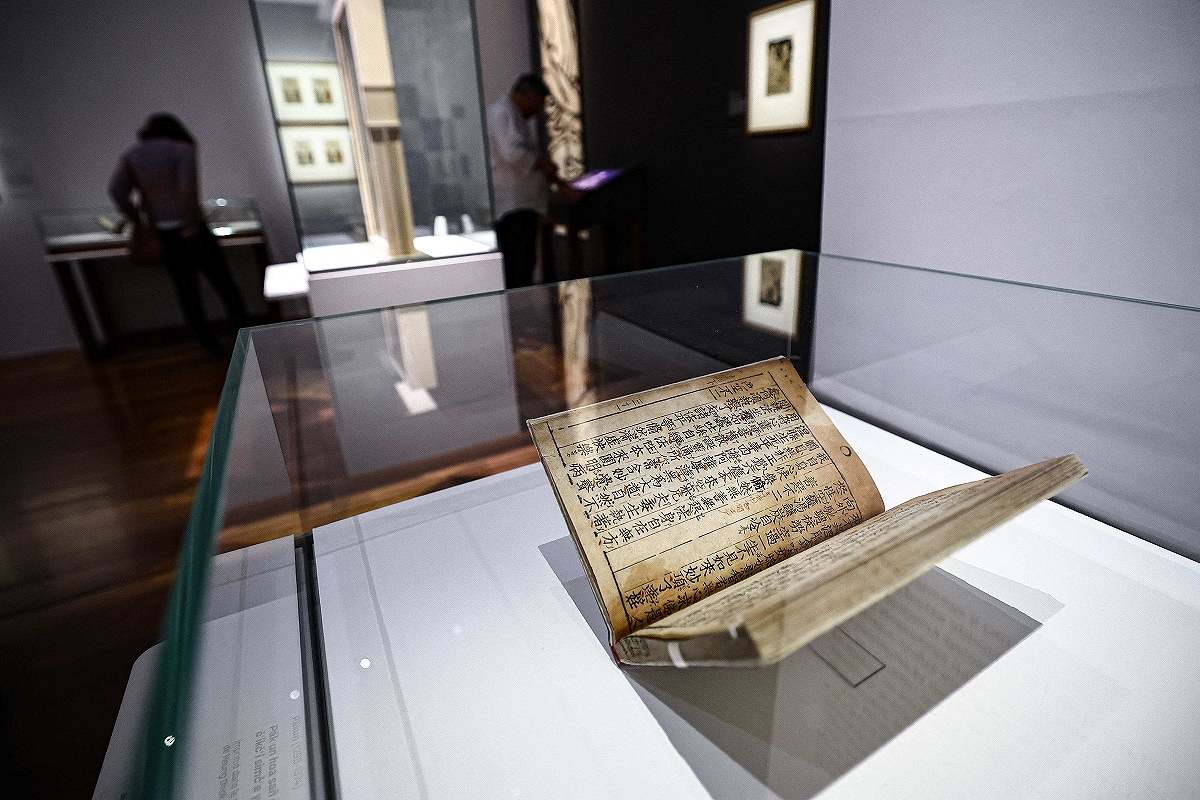
The Jikji, a Korean book, is seen at the National Library of France in Paris on April 12.
14:00 JST, April 21, 2023
PARIS (AFP-Jiji) —The oldest known work printed on a mechanical press — a Korean book that predates the first European example by several decades — went on display in Paris for the first time in 50 years on April 12.
The “Jikji,” a collection of Buddhist teachings, was printed in 1377 — some 78 years before Johannes Gutenberg produced his famous Bible using his printing press in Germany.
The Korean treasure is being shown as part of a new exhibition at the National Library of France (BnF), running until July.
Since no examples of the Korean machinery have survived and the technique did not become widely used at the time, it did not have the revolutionary impact of the Gutenberg press — and the exhibition mostly focuses on European history.
But it marks the first time the “Jikji” has been shown publicly since 1973, according to reports in the Korean press — reigniting hopes of its return.
“With this exhibition as an occasion, if we collaborate and build a good relationship based on trust, I think we could have a valuable opportunity to see Jikji in person in Korea in the future,” said Kim Jung-hee, chair of the Overseas Korean Cultural Heritage Foundation.
The BnF said Gutenberg was probably not aware of the Korean invention, and was combining various forms of reproduction using wood and copper engravings that had been in use in Europe since around 1400, though they themselves were influenced by techniques imported from East Asia.
The “Jikji” was brought to France by Victor Collin de Plancy, who became the first French diplomat to Korea in 1887.
A collector of ancient texts, he bought it from an unknown source and “was emotionally moved to discover that the work dated back to the Xuanguang era (1371-1378),” said the BnF.
It was shown at the Paris Universal Exhibition in 1900 and Collin de Plancy sold it at auction in 1911 for 180 francs, equivalent to more than €60,000 today, according to France’s national statistics bureau.
It was bequeathed to the national library in 1950, and rediscovered a decade later by a Korean historian who was cataloguing her country’s treasures in Paris.
She helped repatriate other items to South Korea, such as royal manuscripts from the Joseon dynasty that had been taken during a French military campaign in 1866.
The exhibition at the BnF also includes a copy of the famous 1455 typographic press designed by Gutenberg and loaned by the museum dedicated to him in Mainz, Germany, as well as two Bibles printed on it, and the oldest known Western woodcut, the Bois Protat, dated to around 1400.
"Science & Nature" POPULAR ARTICLE
-

Genome Study Reveals Milestone in History of Cat Domestication
-

Big Leap in Quest to Get to Bottom of Climate Ice Mystery
-

Security Camera Footage Vulnerable to Outside Access; Investigation Finds 3,000 Pieces Exposed Online
-

Paws on Parade: Nairobi’s Dogs Dazzle at ‘Pawchella’
-

Japan Set to Participate in EU’s R&D Framework, Aims to Boost Cooperation in Tech, Energy
JN ACCESS RANKING
-

Keidanren Chairman Yoshinobu Tsutsui Visits Kashiwazaki-Kariwa Nuclear Power Plant; Inspects New Emergency Safety System
-

Imports of Rare Earths from China Facing Delays, May Be Caused by Deterioration of Japan-China Relations
-

Tokyo Economic Security Forum to Hold Inaugural Meeting Amid Tense Global Environment
-

University of Tokyo Professor Discusses Japanese Economic Security in Interview Ahead of Forum
-

Japan Pulls out of Vietnam Nuclear Project, Complicating Hanoi’s Power Plans

























